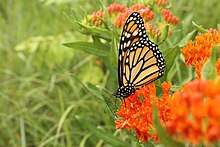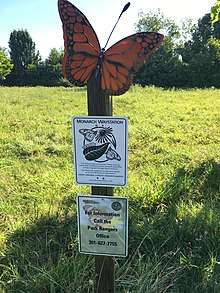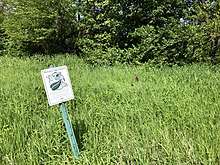Butterfly gardening
Butterfly gardening is a way to create, improve, and maintain habitat for lepidopterans including butterflies, skippers, and moths.[2] Butterflies have four distinct life stages—egg, larva, chrysalis, and adult. In order to support and sustain butterfly populations, an ideal butterfly garden contains habitat for each life stage. Butterfly larvae, except the carnivorous harvester (Feniseca tarquinius), consume plant matter and can be generalists or specialists. While butterflies like the painted lady (Vanessa cardui)[3] are known to consume over 200 plants as caterpillars, other species like the monarch (Danaus plexippus),[4] and the regal fritillary (Speyeria idalia)[5] only consume plants in one genus, milkweed and violets, respectively. Milkweed grows in every state in the United States except Alaska.[6]

As adults, butterflies feed on nectar, but they have also evolved to consume rotting fruit, tree sap, and even carrion.[7] Supporting nectarivorous adult butterflies involves planting nectar plants of different heights, color, and bloom times. Butterfly bait stations can easily be made to provide a food source for species that prefer fruit and sap. In addition to food sources, wind breaks in the form of trees and shrubs shelter butterflies and can provide larval food and overwintering grounds.[8] "Puddling" is a behavior generally done by male butterflies in which they gather to drink nutrients and water and incorporating a puddling ground for butterflies will enhance a butterfly garden.[9][10] While butterflies are not the only pollinator, creating butterfly habitat also creates habitat for bees, beetles, flies, and other pollinators[8]
Reasoning

Butterfly gardening provides a recreational activity to view butterflies interacting with the environment. Besides anthropocentric values of butterfly gardening, creating habitat reduces the impacts of habitat fragmentation and degradation. Habitat degradation is a multivariate issue; development, increased use of pesticides and herbicides, woody encroachment, and non-native plants are contributing factors to the decline in butterfly and pollinator habitat.[11] Pollination is one ecological service butterflies provide; about 90% of flowering plants and 35% of crops rely on animal pollination.[11][12] Butterfly gardens, even in urban, developed neighborhoods provide habitat that increases butterfly diversity and also pollinators like bees, flies, and beetles.[13]
Ground-truthing
Before buying plants and digging into the soil, "ground-truthing" is a necessary first step, Ground-truthing involves surveying a property in order to assess the current resources available. Some aspects to keep in mind are the following:
- south-facing slopes
- natural wind breaks
- present plant species
- present butterfly species
Butterflies are ectothermic and rely on solar radiation for their metabolism. South-facing slopes are an ideal location for a butterfly garden, as they provide the most solar radiation. Shrubs and trees provide wind breaks for butterflies, and can also be host plants, such as spicebush (Lindera benzoin) or pawpaw (Asimina triloba)[8][14]
Plants

The types of plants used in a butterfly garden will determine which species of butterflies will visit a garden. Lepidoptera societies and the Department of Natural Resources often provide state and county distribution maps of local butterflies. There are lists of butterfly species and their host plants which are informative to the plant species needed in the garden (Larval food plants of Lepidoptera). While non-native plants do provide flora resources later in the season, they have an overall negative effect on butterflies and other pollinators.[11] Therefore, it is recommended to use native plants.
Depending on the zone, some butterfly attracting plants include: purple cone flowers (Echinacea purpurea), yellow cone flowers, sunflowers, marigolds, poppies, cosmos, salvias, some lilies, asters, coreopsis, daisies, verbenas, lantanas, liastris, milkweed (especially for the monarch butterfly, whose caterpillars feed solely on this plant), the butterfly bush (also called buddleia), zinnias, pentas, porterweeds, and others.[15] Avoid cultivars of plants that have "double flowers" (more petals which block the center) as these can be difficult for butterflies to access. Care should also be taken to research a species, to make sure it is not invasive in a given region.
Puddling
"Puddling" refers to the behavior of male butterflies congregating on soil, dung, and carrion to feed on nutrients, specifically sodium.[9] Nectar is low in sodium, and sodium is a limiting nutrient for Lepidoptera. Male butterflies are able to transfer sodium to females during copulation. The sodium is passed onto offspring and increases reproductive success.[10] To create a simple puddling habitat, fill a shallow dish (like a draining tray for a pot) with sand. To increase the nutrients, mix compost with the sand. Add footholds for butterflies by adding different sized rocks.
Baiting
There are numerous recipes for creating butterfly bait, but they have common ingredients. Fermentation is the key to a good bait, as it mimics the fermentation of rotting fruit and sap in the natural environment.[16] Recipes include blending rotten fruit (i.e. bananas) with beer, maple syrup, molasses, or sugar. Often yeast is added as well to the mixture and left to ferment for a week. The bait can be laid on stumps, rocks, and tree limbs.

Problems
There are diseases that afflict butterflies, such as bacteria in the genus Pseudomonas, the nuclear polyhedrosis virus, and Ophryocystis elektroscirrha, which only infects queen butterflies and monarch butterflies.
In the absence of pesticides, aphids and true bugs may infest plants. Some gardeners may wish to release ladybugs (ladybirds) and other biological pest control agents that do not harm butterflies in order to control aphids. However, the release of ladybugs is not a good idea in places such as the United States where the species that is released is generally the invasive Chinese ladybug. An alternative to this is to wait for local predatory insects to find the aphids. One technique some use to quicken this process if the infestation is particularly high is to spray the bushes with a mix of sugar and water, simulating aphid honeydew. This is known to attract lacewings whose larva eat aphids.[17] Another method of control is by spraying the plants with water, or rinsing plants with a mild dish detergent/water solution (although caterpillars should be relocated before suds are applied). Scented detergents are fine; those containing OxiClean should be avoided. The aphids will turn black within a day, and eventually fall off. One last technique is to plant a variety of different flowers, including ones that attract hoverflies and parasitic Braconid wasps, whose larvae kill pest species. Still, it is not advisable to kill all aphids, just to control them so that they are not detrimental to plants. Aphids still play a role in the environment by providing food for predators. There are even some caterpillars such as the harvester which only eat certain aphid species instead of plants.[18]
With small home butterfly gardens, it is common for the larvae to exhaust the food source before metamorphosis occurs. Gardeners of monarch butterflies can replace the expended milkweed with a slice of pumpkin or cucumber, which can serve as a substitute source of food for monarch caterpillars in their final (fifth) instar.[19] Planting multiple plants in clumps can help lower the chances of running out of leaves.
Efforts to increase butterfly populations by establishing butterfly gardens require particular attention to the target species' food preferences and population cycles, as well to the conditions needed to propagate their food plants. For example, in the Washington, D.C. area and elsewhere in the northeastern United States, monarch butterflies prefer to reproduce on common milkweed (Asclepias syriaca), especially when its foliage is soft and fresh. As monarch reproduction in that area peaks in late summer when most Asclepias syriaca leaves are old and tough, the plant needs to be cut back in June – August to assure that it will be regrowing rapidly when monarch reproduction reaches its peak.[20][21][22]
In addition, Asclepias syriaca seed needs a period of cold treatment (cold stratification) before it will germinate.[21] Further, monarch caterpillars do not favor butterfly weed (Asclepias tuberosa) because the leaves of that milkweed species contain little toxin (cardiac glycosides), which monarchs tolerate but which many predators of butterflies do not.[22]
See also
- Butterfly house (conservatory)
- Category: Lists of Lepidoptera by food
- Category: Lists of butterflies
References
- Brower, Lincoln P.; Taylor, Orley R.; Williams, Ernest H.; Slayback, Daniel A.; Zubieta, Raul R.; Ramírez, M. Isabel (March 2012). "Decline of monarch butterflies overwintering in Mexico: is the migratory phenomenon at risk?: Decline of monarch butterflies in Mexico". Insect Conservation and Diversity. 5 (2): 95–100. doi:10.1111/j.1752-4598.2011.00142.x. hdl:2060/20140010155.
- "Butterfly Gardening: Introduction". University of Kansas: Monarch Watch. Archived from the original on February 2, 2020. Retrieved March 9, 2020.
- Krenn, Harald W. (December 24, 2001). "Proboscis musculature in the butterfly Vanessa cardui (Nymphalidae, Lepidoptera): settling the proboscis recoiling controversy". Acta Zoologica. 81 (3): 259–266. doi:10.1046/j.1463-6395.2000.00055.x. ISSN 0001-7272.
- "Plant Milkweed for Monarchs" (PDF). MONARCH JOINT VENTURE Partnering across the U.S. to conserve the monarch migration. Monarch Joint Venture. Archived from the original (PDF) on 21 May 2015. Retrieved 7 July 2015.
- "Supplemental Information 3: Dendrogram showing Bray-Curtis similarities in lepidopteran community between host plants". doi:10.7717/peerj.3344/supp-3. Cite journal requires
|journal=(help) - Johnson, Glen A. Milkweed of the United States Including Puerto Rico and the US Virgin Islands. ISBN 9781081170653.
- Ômura, Hisashi; Honda, Keiichi (November 2003). "Feeding responses of adult butterflies, Nymphalis xanthomelas, Kaniska canace and Vanessa indica, to components in tree sap and rotting fruits: synergistic effects of ethanol and acetic acid on sugar responsiveness". Journal of Insect Physiology. 49 (11): 1031–1038. doi:10.1016/j.jinsphys.2003.07.001. PMID 14568581.
- Attracting native pollinators : protecting North America's bees and butterflies : the Xerces Society guide. Lee-Mäder, Eric, 1972-, Xerces Society. North Adams, MA: Storey Pub. 2011. ISBN 978-1-60342-695-4. OCLC 535495615.CS1 maint: others (link)
- Pivnick, Kenneth A.; McNEIL, Jeremy N. (December 1987). "Puddling in butterflies: sodium affects reproductive success in Thymelicus lineola*". Physiological Entomology. 12 (4): 461–472. doi:10.1111/j.1365-3032.1987.tb00773.x. ISSN 0307-6962.
- Smedley, S. R.; Eisner, T. (December 15, 1995). "Sodium Uptake by Puddling in a Moth". Science. 270 (5243): 1816–1818. Bibcode:1995Sci...270.1816S. doi:10.1126/science.270.5243.1816. ISSN 0036-8075. PMID 8525374.
- Hanula, James L.; Ulyshen, Michael D.; Horn, Scott (October 2016). "Conserving Pollinators in North American Forests: A Review". Natural Areas Journal. 36 (4): 427–439. doi:10.3375/043.036.0409. ISSN 0885-8608. S2CID 12503098.
- Nicholls, Clara I.; Altieri, Miguel A. (April 2013). "Plant biodiversity enhances bees and other insect pollinators in agroecosystems. A review" (PDF). Agronomy for Sustainable Development. 33 (2): 257–274. doi:10.1007/s13593-012-0092-y. ISSN 1774-0746. S2CID 11207837.
- Matteson, Kevin C.; Langellotto, Gail A. (September 2010). "Determinates of inner city butterfly and bee species richness". Urban Ecosystems. 13 (3): 333–347. doi:10.1007/s11252-010-0122-y. ISSN 1083-8155.
- Wagner, David L. (December 31, 2010). Caterpillars of Eastern North America. Princeton: Princeton University Press. doi:10.1515/9781400834143. ISBN 978-1-4008-3414-3.
- (1) "Butterfly Gardening". Butterflies for All Occasions. 2008. Retrieved May 27, 2008.
(2) Glassberg, J. (1995). Enjoying butterflies more: attract butterflies to your backyard. Marietta, Ohio: Bird Watcher's Digest Press. ISBN 1880241080. LCCN 96202681. OCLC 35808599. Retrieved March 9, 2020 – via Google Books.
(3) "Monarch Garden Plants" (PDF). San Francisco, California: Pollinator Partnership. Archived from the original (PDF) on March 9, 2020. Retrieved March 9, 2020. - Laaksonen, Jesse; Laaksonen, Toni; Itämies, Juhani; Rytkönen, Seppo; Välimäki, Panu (June 1, 2006). "A new efficient bait-trap model for Lepidoptera surveys – the "Oulu" model". Entomologica Fennica. 17 (2): 153–160. doi:10.33338/ef.84301. ISSN 2489-4966.
- Omkar (February 3, 2016). Ecofriendly Pest Management for Food Security. Academic Press. ISBN 9780128032664 – via Google Books.
- "harvester butterfly – Feniseca tarquinius (Fabricius)". entnemdept.ufl.edu. Retrieved November 13, 2017.
- Maeckle, Monika (April 11, 2014). "Milkweed Shortage Sparks "Alternative Fuels" for Hungry Monarch Caterpillars". [Texas Butterfly Ranch]. Archived from the original on April 7, 2015. Retrieved June 1, 2015.
- (1) Higgins, Adrian (May 27, 2015). "A gardener's guide to saving the monarch". Home & Garden. The Washington Post. Archived from the original on June 3, 2015. Retrieved May 29, 2015.
(2) Higgins, Adrian (May 27, 2015). "7 milkweed varieties and where to find them". Home & Garden. The Washington Post. Archived from the original on June 3, 2015. Retrieved May 29, 2015. - (1) Gomez, Tony. "Asclepias Syriaca: Common Milkweed for Monarch Caterpillars". [MonarchButterflyGarden.net]. Archived from the original on March 16, 2015. Retrieved May 29, 2015.
(2) "Common Milkweed: Asclepias syriaca L." (PDF). Plant Guide. United States Department of Agriculture: Natural Resources Conservation Service. Archived from the original (PDF) on March 27, 2015. Retrieved May 29, 2015.
(3) "Asclepias syriaca". butterfly gardening & all things milkweed. Archived from the original on July 7, 2015. Retrieved July 7, 2015.
(4) "Plant Milkweed for Monarchs" (PDF). MONARCH JOINT VENTURE Partnering across the U.S. to conserve the monarch migration. MONARCH JOINT VENTURE. Archived from the original (PDF) on July 7, 2015. Retrieved July 7, 2015. - Abugattas, Alonzo (January 3, 2017). "Monarch Way Stations". Capital Naturalist. Archived from the original on June 5, 2017. Retrieved June 5, 2017 – via Blogger.
